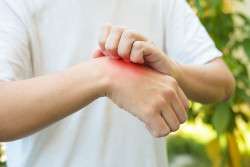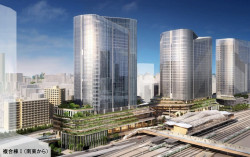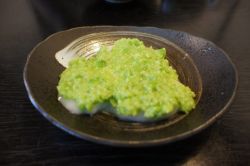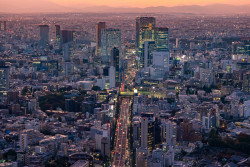
Originally published on metropolis.co.jp on October 2011

The spectacular trail of the Shirogane Fudo Myo-o Waterfall Track, on the slopes of Mount Takachidake in Hokkaido’s Daisetsuzan National Park, was laid out by migrants from the southern island of Shikoku, and is a mini-version of that island’s famous “88 temples” pilgrimage trail. This series of engraved stones at hundred-meter intervals is presided over by the wrathful deity Fudo Myo-o, the “eternal, immutable diamond” of Japanese Buddhism. He carries in his left hand a noose to lasso evil spirits, and in his right a sword to slash through ignorance.
Also around to banish my ignorance—of the trail at least—is Australian Chuck Olbery, who with his Japanese wife Toshie runs MBT Hokkaido, mountain-bike tour operators. Starting from the Shirogane Information Center, our route will traverse Biruke no Mori forest before veering onto the Fudo Myo-o Waterfall track, uphill and over the Biei River Gorge—then downhill via another forest track to the start, at speeds of up to 40 km/h. With the autumn leaves at their most spectacular, it seems this itinerary will guarantee not just thrills but an eye-feast beyond peer.
Biruke no Mori means “Silver Birch Forest,” explains Olbery, as we set off through trees bearing leaves in a hundred shades of red and yellow. “But the native Ainu of Hokkaido used to call this place ‘The Forest of the Little People,’” he adds. Little people?
It’s only later I hear of the Ainu koropokkuru, a pygmy some archaeologists say really existed. Tiny “human” footprints are said to have been discovered in the rice fields of northern Japan dating from the Jomon era, around 10,000 years ago. According to some legends, the koropokkuru are quasi-divine creatures small enough to live under the leaves of the butterbur (or “dinosaur plant”), and can either help or play tricks on people according to whim.
Fortunately the koropokkuru are in a good mood today, and I miraculously manage to stay on the mountain bike. As we enter the waterfall track, Olbery points out how to negotiate the slippery trail that lies ahead. “When you come across a tree root, try not to let the bike drift sideways”, he says. “Take it at a decent speed, and jump over the roots if you can.”
By now, we’ve reached the super-scenic Fudo Falls, which cascade down through a russet-coloured canyon. Shirohige-no-taki is a 30-meter waterfall flowing down into the vividly turquoise-coloured Biei River. The waterfall is unique in that it is not located on a river at all, rather made up of ground water that flows out dozens of fissures in the cliff-face.
Overlooking the waterfall, a giant statue of Fudo Myo-o keeps silent watch. I’m told the deity has the secondary role of protecting travellers. His companion is the Jizo Bodhisattva (Kshitigarbha), whose role is to ease the suffering and reduce the sentence of those languishing in hell. Maybe there is hope for me yet.
At Shirogane Shrine, right at the foot of the waterfall, smaller statues of the godly couple are adorned with fresh flowers placed by devotees. From here, the trail narrows and winds uphill. All along the way, shrine stones mark the tortuous zigzags.
Along the route, my faithful guide passes on more pearls of mountain biking wisdom. “Pay attention to your body position,” he says. “Stay centered on flat sections, but bring your weight slightly forward on uphill climbs and back on descent.”
I’m also told to “feather the brakes”—that is, not brake the whole time down a hill, but alternate between braking and not braking. Another tip is to look well ahead for the best possible line through openings, and between obstructions such as trees or rocks.
In a tree-shaded clearing, large statues of pilgrims on the Shikoku 88-temple route seem to speak of the value in the journey—the overcoming of obstacles—rather than the destination. That certainly seems to me to be the joy in such an expedition.
Thanks to Fudo Myo-o, I manage to get to the top of the trail in one piece. At the trailhead, the Shirogane-bashi Bridge offers spectacular views over the Biei River Gorge and the 30-meter high, multi-streamed Shirohige-no-taki waterfall. The vivid cobalt blue of the river and the golden-orange autumn leaves together make a picture that could have leapt straight off a painter’s easel.
And then it’s all downhill, along another exhilarating trail back to the Shirogane Information Center, passing en route an emerald lake studded with flooded silver birch trunks. After this, it may be time to do the whole loop all over again, but this time more slowly—maybe on foot. Slow and steady may not always win the race, but in a “race” like this there are no real losers.
getting there
- The Shirogane Falls and trail are about 18km from the town of Biei, itself a 20-30-minute drive from Hokkaido’s Asahikawa Airport.
- MTB Hokkaido: www.mtbhokkaido.net.
- MTB’s website www.biketoursjapan.com offers a range of tours covering the whole of the island.










